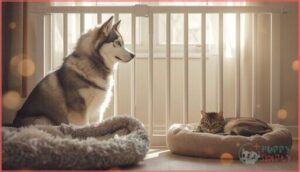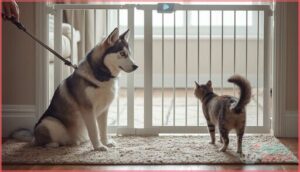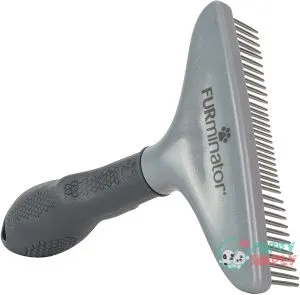This site is supported by our readers. We may earn a commission, at no cost to you, if you purchase through links.

Picture a Husky trotting into your living room, tail high and eyes bright, only to freeze mid-step as your cat arches her back and puffs up like a feather duster. You can almost feel the tension crackle in the air.
Huskies aren’t your average family dog—they’re born with a chase instinct that’s hardwired into their DNA, thanks to generations spent running across frozen tundra. That wild streak can make the idea of harmony with a housecat seem like wishful thinking.
But with the right approach, you’ll discover that do huskies get along with cats isn’t just a question—it’s a challenge worth tackling.
Table Of Contents
Key Takeaways
- Huskies possess a hardwired prey drive from their breeding history as sled dogs and hunters, with 53% displaying strong hunting instincts that make cohabitation with cats challenging without proper management and early socialization before 12 weeks of age.
- Successful husky-cat relationships depend on gradual introductions using scent acclimation, visual barriers, and supervised meetings paired with consistent obedience training (sit, stay, leave it) and positive reinforcement methods that reduce chasing behaviors by up to 47%.
- Individual husky personalities vary significantly—show-line huskies display aggression toward cats only 8% of the time compared to 24% in working-line dogs—meaning temperament assessment and past experiences with cats are critical factors in predicting compatibility.
- Daily vigorous exercise (1-2 hours) combined with mental stimulation, separate safe spaces for cats (vertical escape routes, baby gates), and vigilant monitoring for stress signals (whale eye, hissing, stalking) are essential for maintaining safe coexistence in multi-pet households.
Why Huskies Struggle With Cats
Huskies weren’t always house pets—they were bred to pull sleds across frozen tundra and hunt for survival. That history left them with instincts that don’t always mesh well with life alongside a cat.
Before you bring these two animals together, it’s important to understand what makes huskies tick and why those traits can create real challenges in a multi-pet home.
High Prey Drive Explained
Your husky’s prey drive isn’t something you can train away—it’s hardwired into their DNA. Research shows 53% of Siberian Huskies display strong hunting instincts, with 41% showing intense chasing behaviors. This breed specificity stems from canine evolution; huskies were bred to work independently in harsh Arctic conditions, where hunting meant survival.
When you introduce a high-energy husky to cats, you’re dealing with primal behavior that’s difficult to redirect. Understanding the breed’s high prey drive is essential for successful cohabitation.
Independent and Stubborn Nature
Beyond prey drive, you’re working with a breed shaped by genetic factors that favor self-reliance. Studies show up to 67% of breed independence stems from genetics, making training challenges unavoidable. Huskies ignore commands 50% of the time under distractions—not out of spite, but because their canine personality values autonomy over pleasing you.
Here’s what impacts husky cat compatibility:
- Selective hearing during training sessions
- Problem-solving without seeking your approval
- Escape attempts driven by independence (63% of owners report this)
- Lower hierarchical bonding with other pets
- Slower learning curves despite consistent routines
This canine behavior complicates managing their prey drive around cats. Understanding their high energy needs is essential for effective training and socialization.
High Energy and Playfulness
That independence pairs with relentless physical demands—Huskies need 1 to 2 hours of vigorous exercise daily. Without it, their playful behavior escalates into chaos around smaller pets.
Their breed characteristics include rough play fighting that mimics pack dynamics, which overwhelms cats unintentionally. Energy management through structured pet training and positive reinforcement helps, but socialization tips alone won’t solve their stamina-driven intensity during interactions.
Strong Bite and Safety Concerns
Beyond raw power, your Husky’s bite force poses real concerns in mixed-species homes. Their estimated 220 to 320 PSI doesn’t automatically spell disaster, but paired with prey drive, it creates situations needing immediate aggression management and bite risk assessment.
Consider these safety precautions for injury prevention:
- Multiple body area injuries occur in 71% of cat bite cases
- Working-line Huskies show 24% aggression rates versus show-line’s 8%
- Bite force measurement reveals strength exceeding German Shepherds
- Fatal incidents disproportionately affect vulnerable small animals
- Husky and cat compatibility demands constant supervision initially
When Huskies and Cats Can Get Along
Not every Husky is destined to see your cat as prey. When introduced early and trained consistently, many Huskies can learn to accept cats as part of their pack rather than something to chase. The key lies in understanding which factors increase your chances of success.
Early Socialization Benefits
When you introduce your Husky to cats early—ideally before 12 weeks—you’re setting the stage for social bonds that can last a lifetime. This critical window shapes how your dog perceives other species, dramatically improving behavioral adaptation and fear reduction.
Early canine socialization through positive reinforcement builds calm environments where both animals learn stress management naturally, making introducing Huskies and cats far more successful than adult pairings.
Positive Past Experiences With Cats
Experience shapes everything regarding dog-cat relationships. When your Husky grows up alongside feline companions, they’re learning to view cats as family rather than prey, building canine empathy that transforms household harmony naturally.
A Husky raised with cats learns to see them as family, fostering empathy and harmony instead of instinctive prey
Here’s what positive past experiences with cats usually create:
- Social bonds form as your Husky recognizes cats as pack members deserving respect and gentleness
- Feline trust develops through months of calm, supervised interactions that replace fear with curiosity
- Reduced chasing behaviors emerge because familiarity overrides instinctive prey drive responses
- Pet friendship blossoms when Huskies learn appropriate play boundaries through consistent positive reinforcement
- Mutual comfort grows as both species adapt to shared spaces, sometimes resting near each other peacefully
Introducing dogs and cats during puppyhood—especially before 12 weeks—gives your Husky the best foundation. But don’t lose hope if you’re working with an adult dog. Many owners report success after patient, gradual introductions spanning months or even years. The key difference? Huskies and cats who share positive early memories treat coexistence as normal, not threatening.
Impact of Training and Routine
Consistent training methods transform how your Husky views your cat. Basic obedience commands—sit, stay, leave it—give you critical control during close encounters. Dogs attending training courses longer than six months show markedly reduced aggression and behavioral problems, making routine schedules essential for behavior modification.
Reward-based techniques reduce unwanted chasing by up to 47% in young Huskies, proving consistency matters deeply in dog-cat relationships. When you establish predictable routines—feeding times, play sessions, training moments—both animals adjust faster. Introducing dogs and cats becomes manageable when pet training and behavior follows structured, patient approaches that redirect energy appropriately.
| Training Element | Impact on Husky | Result for Cat |
|---|---|---|
| Positive reinforcement with treats | Strengthens calm responses | Reduced stress levels |
| Daily exercise routine | Decreases restlessness | Safer shared spaces |
| Consistent command enforcement | Maintains obedience | Predictable interactions |
| Impulse control exercises | Mitigates prey drive | Enhanced security |
Personality Differences Among Huskies
Not every Husky shares the same temperament—individual personality shapes whether your Siberian Husky will peacefully coexist with cats. While breed variations include high prey drive and pack mentality tendencies, canine intelligence and social learning abilities differ dramatically between dogs.
- Show-line Huskies demonstrate physical aggression toward cats only 8% of the time, compared to 24% among working-line dogs
- Males often display stronger pack dynamics and dependency, potentially affecting cat relationships
- Independence levels vary widely, influencing trainability and impulse control around smaller animals
Safely Introducing a Husky to a Cat
Introducing a Husky to a cat isn’t something you can rush—it takes a thoughtful, step-by-step approach to keep both animals safe and comfortable. The key is giving them time to adjust at their own pace while you stay calm and in control.
Here are the essential steps to help your Husky and cat build a peaceful relationship from day one.
Gradual and Controlled Introductions
The foundation of successful dog-cat relationships starts with gradual introduction strategies that respect each animal’s boundaries. You’ll want to begin with controlled meetings where your husky stays on-leash while the cat moves freely, ensuring safe spaces exist for retreat.
These brief sessions—lasting just 5-10 minutes initially—allow both pets to acclimate without overwhelming stress, building trust through careful, patient exposure.
Visual and Scent Acclimation Steps
Before your husky and cat meet face-to-face, scent introduction techniques lay the groundwork for safe encounters. Swap bedding between pets so each becomes familiar with the other’s scent in a low-stress way.
Next, use visual barriers like baby gates for controlled viewing sessions—short, calm exposures where you can reward your husky’s calming signals.
These animal socialization techniques help both pets acclimate gradually, strengthening dog-cat relationships through patient, structured pet introductions.
Supervising First Interactions
Once your pets have acclimated through scent and visual introductions, it’s time for supervised meetings. Keep your husky on a leash during these first encounters—leash training gives you immediate control if prey drive kicks in. Use commands like “sit” and “leave it” to manage behavior.
Create safe spaces with environmental controls like baby gates, and never leave huskies and cats unsupervised until they’ve proven they can coexist peacefully.
Recognizing and Managing Stress
Even with careful setup, watching for signs of fear and aggression keeps everyone safe. Your husky’s dilated pupils, excessive panting, or whale eye signal stress. Cats showing territorial behavior—ears flat, hissing—need space immediately.
To reduce anxiety and modify behavior, try these calming techniques:
- Speak softly and avoid sudden movements during introductions
- Reward calm responses with treats for both pets
- Provide escape routes so your cat won’t feel cornered
- Keep sessions short—five minutes initially prevents overstimulation
- Use puzzle toys to redirect your husky’s focused energy
Recognizing stress signals early prevents escalation.
Training Techniques for Husky-Cat Harmony
Training your husky to respect your cat isn’t about fighting their instincts—it’s about redirecting them into behaviors that work for everyone under one roof. The right techniques can help your husky learn self-control while giving your cat the peace of mind they deserve.
Let’s look at four proven training methods that create lasting harmony between these very different animals.
Basic Obedience Commands
Teaching your husky reliable command training is essential before introducing cats into your home. You’ll want to master five core obedience tips: sit, stay, come, down, and heel. These commands build impulse control and improve leash manners, creating a foundation for safe canine communication. Train using clear verbal cues paired with hand signals during short, frequent sessions.
| Command | Purpose for Cat Safety |
|---|---|
| Sit/Stay | Controls impulse when cat moves quickly |
| Come | Recalls husky away from chase situations |
| Down | Reduces excitement and intimidation toward cats |
| Heel | Controls energy during shared household movement |
Positive Reinforcement Methods
Once you’ve established basic obedience, positive reinforcement becomes your most powerful tool for shaping peaceful dog-cat relationships. Reward timing matters—delivering treats within seconds of calm behavior around cats boosts learning effectiveness by up to 50%. Training consistency is key for behavioral retention:
- Reward your husky immediately when they ignore or calmly observe the cat
- Use high-value treats during controlled introduction sessions
- Maintain predictable reward schedules to strengthen desired responses
This approach reduces unwanted chasing in huskies and cats by approximately 35% over two months.
Redirecting Prey Drive
You can channel your husky’s intense prey drive into safe outlets using Predation Substitute Training (PST). This behavioral modification approach lets your dog satisfy their natural instincts through controlled activities like fetch, tug-of-war, or flirt pole chases.
When you redirect energy this way, you’ll reduce inappropriate chasing by nearly 47% while strengthening canine and feline coexistence through structured play sessions.
Consistency and Patience in Training
Training your husky to coexist with cats works best when you stick to the same approach every single day. Patient owners who maintain consistent commands see up to 70% more reliable canine behavior during the introduction phase. Here’s how to build lasting canine and feline coexistence:
- Schedule short 5–15 minute training sessions at the same times daily
- Use identical commands across all settings to reduce confusion
- Implement reward systems immediately after correct responses
- Track your progress in writing to adjust training schedules
- Celebrate small wins to strengthen dog cat relationships over time
Managing Common Challenges in Cohabitation
Even with the best training and introductions, living with both a husky and a cat isn’t always smooth sailing. You’ll likely face moments of tension, unexpected behavior, or signs that one pet isn’t feeling safe.
The good news is that most challenges can be managed with a few practical strategies and a willingness to adapt as you go.
Creating Separate Safe Spaces
You can reduce stress and prevent conflict by establishing dedicated safe zones for your cat. Cat towers and vertical barriers give your feline escape routes when needed. Baby gates with built-in cat doors create secure enclosures where your cat controls access. Hidden compartments behind furniture offer additional cat safety measures.
These environmental modifications support dog-cat coexistence while you introduce boundaries that protect pet safety during daily interactions.
Monitoring for Aggression or Fear
Recognizing Husky aggression early can prevent serious harm during the delicate process of introducing Huskies and cats. Watch for behavioral cues like stiff posture, intense staring, and raised hackles in your Husky, while fear signs in cats include pinned ears and defensive hissing. These aggression triggers demand immediate intervention through safety protocols and stress reduction techniques, helping you protect both pets from injury.
Key warning signs to watch during interactions:
- Freezing or stalking behavior — your Husky fixates on the cat with unwavering focus
- Growling or baring teeth — canine aggression escalating beyond playful interaction
- Lunging or snapping motions — dangerous predatory responses requiring separation
- Cat hiding constantly — chronic fear indicating your feline feels unsafe
- Dilated pupils in either pet — heightened stress levels signaling potential conflict
Providing Adequate Exercise and Stimulation
Your Husky’s excess energy can fuel prey drive behaviors toward your cat, making daily exercise non-negotiable for safe cohabitation.
Adult Huskies require 1-2 hours of vigorous physical activity daily—running, hiking, or agility work—to manage their high energy levels effectively.
Combine this with mental stimulation through puzzle toys and training sessions, which reduces stress and redirects focus away from chasing behaviors.
When to Seek Professional Help
Sometimes, despite your best efforts, the situation between your Husky and cat doesn’t improve—that’s when veterinary consultation becomes essential for animal welfare.
Watch for these aggression signs that demand immediate intervention:
- Persistent lunging, growling, or snapping despite consistent training efforts
- Either pet showing ongoing fear, stress, or defensive behaviors
- Physical injuries occurring during interactions
A certified animal behaviorist can provide behavior therapy customized to managing pet aggression through stress management techniques and pet behavior training, determining the right intervention timing for your household’s safety.
Top 3 Products for Husky and Cat Households
Managing a husky and cat household doesn’t have to feel like you’re juggling hand grenades. The right tools can make daily life smoother, reduce stress for both animals, and help you maintain the peaceful coexistence you’ve worked so hard to build.
Here are three practical products that address the specific challenges of husky-cat households.
1. Husky Puppy Training The Ultimate Guide
Managing the early months with a Husky puppy can feel like learning a new language—one built on Puppy Socialization, Obedience Training, and creative Behavior Modification. “Husky Puppy Training The Comprehensive Guide” arms you with practical Housebreaking Tips and Dog Training Techniques, adapted for the breed’s unique temperament.
For instance, it emphasizes consistent routines and positive reinforcement, vital for Husky puppy socialization and managing their boundless energy. If you’re seeking reliable Introduction and Training advice, this digital book brings clarity to the chaos.
2. FURminator Grooming Rake for Dogs Cats
Once you’ve tackled training, keeping fur under control becomes your next challenge in a Husky and cat household. The FURminator Grooming Rake stands out among grooming tools for its rotating metal teeth, which work wonders on thick coats.
With daily use, you’ll notice less loose hair floating around—helpful for pet hair management and dog shedding solutions. Its ergonomic handle makes it easy for you, while gentle detangling promotes pet compatibility and stress-free cat grooming tips. It’s a simple way to support dog-cat coexistence.
3. Self Cleaning Pet Hair Brush
If you’re tired of fur piling up after grooming, a self-cleaning pet hair brush brings real relief. Its retractable bristles allow quick hair removal, making brush maintenance a breeze for busy households with Huskies and cats.
The ergonomic handle helps reduce hand fatigue, while fine, angled bristles suit different dog breeds and cat compatibility needs.
Regular use promotes pet hygiene and hair removal, keeping your space cleaner. For anyone juggling pet care and management, this tool streamlines your grooming routine.
Frequently Asked Questions (FAQs)
Can huskies and cats share food bowls safely?
No, huskies and cats shouldn’t share food bowls. Nutritional needs differ markedly—cats require taurine, which dog food lacks.
Shared bowls increase bacterial transmission risks and can trigger food-related aggression between your pets.
What signs show a husky is stressed around cats?
Your husky’s body language tells you everything. Watch for pacing, excessive panting, whale eye, pinned ears, and tense posture.
Vocal cues like whining or growling signal anxiety, while avoidance behaviors reveal discomfort around cats.
How do huskies react to kittens versus adult cats?
Most owners notice their dogs display greater playfulness toward kittens, approaching with curiosity rather than aggression.
Adult cats typically trigger more cautious reactions due to established boundaries and assertive body language that influences canine socialization dynamics.
Are certain cat breeds better with huskies?
While breed matters less than personality, confident cats like Siamese and Abyssinians tend to adapt better to huskies. Bold, territorial cats can stand their ground, reducing prey drive triggers and promoting safer dog-cat coexistence.
Do huskies’ sleeping habits affect cat interactions?
Sleep patterns markedly influence dog-cat coexistence. Restless nights and nocturnal behavior in canines increase nighttime disturbances, potentially escalating feline stress.
Canine fatigue from fragmented rest may heighten anxiety-like symptoms, affecting interspecies relationships and overall animal behavior negatively.
Conclusion
Think of your home as a stage where two very different actors must learn their cues. With patience, structure, and vigilance, you can teach your Husky and cat to share the spotlight without drama.
The question “do huskies get along with cats” doesn’t have a one-size-fits-all answer, but the tools you’ve gained here give you a real shot at success. Trust the process, stay consistent, and celebrate small victories along the way.
- https://featured.com/questions/do-huskies-get-along-with-cats-we-want-to-hear-first-hand-experiences-from-pet-owners-or-pet-professionals
- https://foreverhusky.org/husky-101/huskies-and-cats/
- https://www.dogster.com/lifestyle/do-huskies-get-along-with-cats
- https://www.reddit.com/r/husky/comments/1lk8c5m/a_husky_and_a_cat/
- https://pmc.ncbi.nlm.nih.gov/articles/PMC11145769/

















